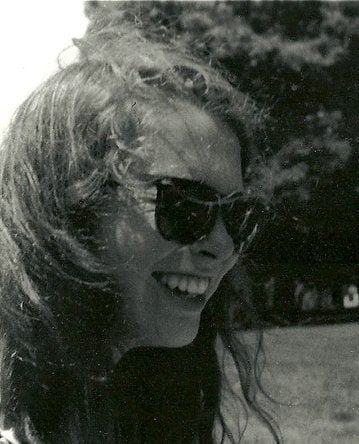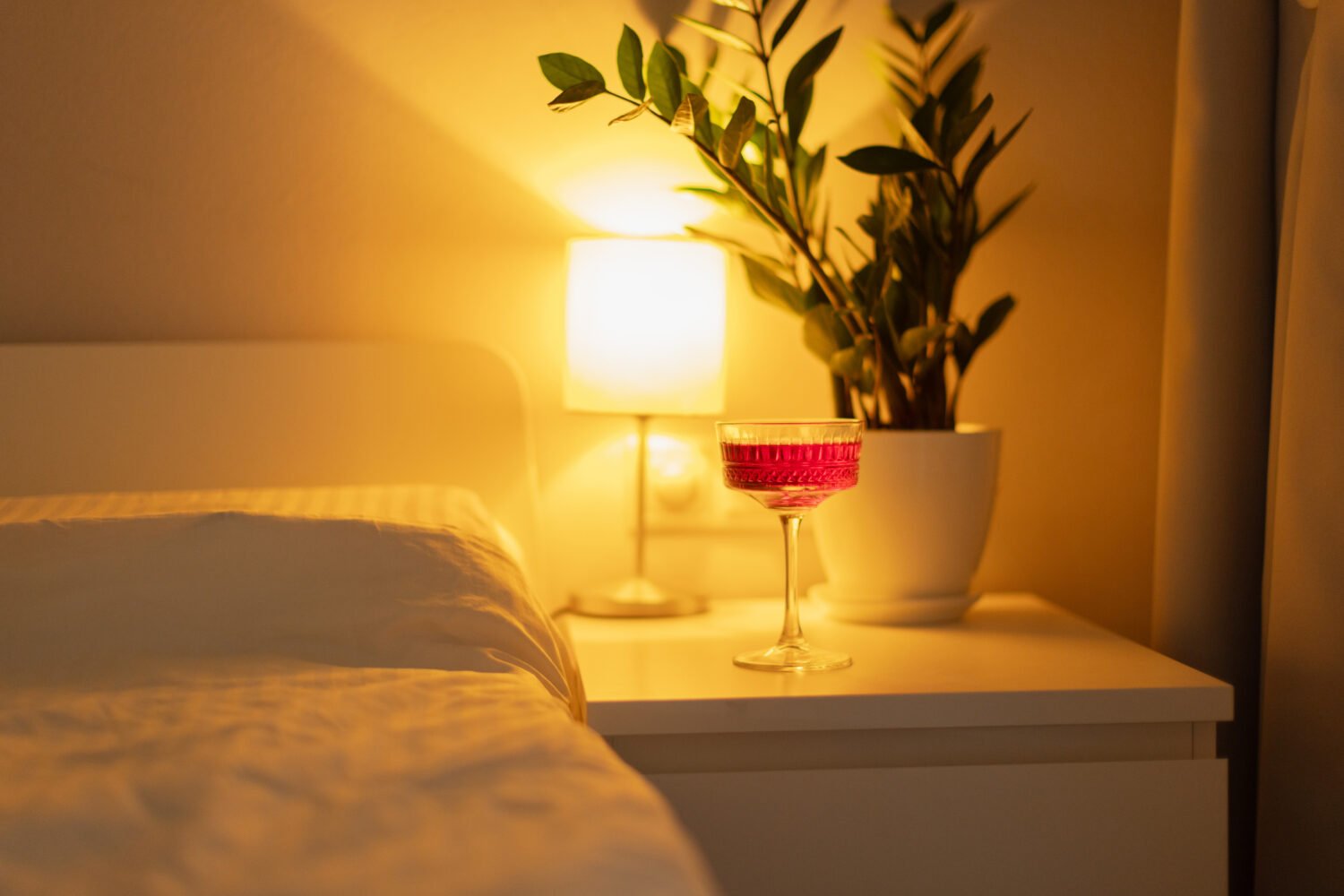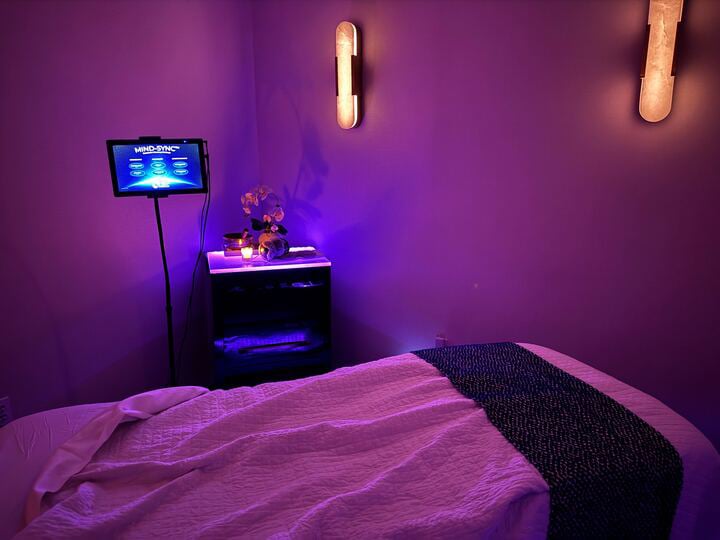Bringing a third party into the marital bed can be a tricky thing. The logistics alone are daunting. When a couple becomes a throuple, just where is everyone supposed to go?
For John Schuettinger, 41, and Danielle Henry, 40, the second question proved easy: All they had to do was clear a space on Schuettinger’s nightstand in the master bedroom of their Northeast DC home.
The friends-with-benefits third party, in this case, is a white rectangle with rounded edges, “about the size of a loaf and a half of bread,” Schuettinger says: a CPAP machine, which sashayed into their life after he was diagnosed with sleep apnea. The device lives on a purple dishtowel next to the bed, with a tube extending like a Slinky, to be affixed umbilical-style to Schuettinger’s face.
Obviously, the new bedmate’s tastes and needs took some time getting used to. It whirs at night. It asks for water and is a diva about it—only distilled water, please. It’s not an easy companion when it comes along on a camping trip. To accommodate it, Schuettinger had to break his habit of sleeping on his stomach. As one would expect from a device that hooks up nightly to a human face, it can get kind of gross if you don’t clean it.
Also, the couple’s young son was terrified of the machine at first. “He gets freaked out and runs away like a dog with a Roomba,” says Henry.
For a lot of couples, this kind of change in domestic arrangements can bring up significant emotional issues. The device can profile as a totem of creeping middle-aged unsexiness—even before you glimpse yourself in the mirror. Schuettinger, though, was well past worrying. “My existential crisis happened long before the CPAP,” he says.
So he’d rather talk about the upsides of this medical ménage à trois. Pre-CPAP, Schuettinger was a horrific snorer. “Like if Chewbacca was belligerently drunk,” says Henry. “He’d go take a nap and it’d reverberate through the whole house.” But he’d also frequently come down with colds and find it hard to recover, and he never felt properly rested. He’d wake up several times a night and drift off to sleep at his desk or while the kids were on the playground.
Henry, for her part, no longer has to head to the couch to get some sleep. And she has come to like the new bedmate’s style. The CPAP’s whirring serves as a kind of white noise. “It’s so quiet in comparison to what was essentially—” She pauses, gearing up for her impression of Schuettinger’s snore before emitting a noise akin to that of a thousand fireworks exploding in a nuclear plant.
In the world of sleep medicine, this makes Schuettinger a success story. According to the American Academy of Sleep Medicine, nearly 30 million US adults have obstructive sleep apnea, the deceptively simple term for a disorder in which you intermittently stop breathing while asleep. Side effects can include stroke. The most common way to mitigate it is a CPAP machine—the initials stand for continuous positive airway pressure—which pushes oxygen into a sleeper’s airway to keep it from collapsing. According to the American Sleep Association, the machines range from $500 to $3,000, a cost that may be covered by insurance. Beyond price, there’s a problem: Some people are dead-set against bringing the thing into their bedroom.
Look at one and you’ll see why. Some of the devices curl a small tube under the nose like a hospital oxygen line, but others are Darth Vader contraptions with a mask that slides over the mouth like a fighter pilot’s. Schuettinger and Henry’s kid isn’t the only one freaked out about the machine.
Sleep apnea tends to affect people as they get older, so it’s less likely you’d see a twentysomething lugging a CPAP machine to a bar in case a one-night stand is on the horizon. All the same, it does pose challenges in the intimacy department. No one wants to have a booty call stumble over a nasal hose in the dark.
Quianna Taylor, 37, had already been in a long-term relationship with her boyfriend when he was diagnosed with apnea, so there was no awkward reveal at the first sleepover. But he did have to adjust his nighttime routine. Taylor’s boyfriend often sleeps at her house in Brentwood, and he’ll show up toting his machine in a small bag. It’s not a device suited to nocturnal spontaneity. The two make a point of getting in a goodnight kiss before he hooks himself up, and they’ve had to revamp their snuggle architecture. “I used to be the little spoon,” says Taylor, “and now he’s the little spoon.”
She adds that if she were ever diagnosed with apnea—she suspects she might suffer from it—she’d be up for getting matching machines. “That would be so cute. I would 100 percent be like, ‘We should both get the blue.’ ”
“I got it and I was like, ‘Okay, this is super not cute,’ ” says Tiffany Bridge, 41, of Brookland, who has named her CPAP Frank. “You feel kind of like a scuba diver, or maybe one of the rebel pilots from Star Wars.”
Bridge was diagnosed with sleep apnea after her husband recorded her snoring and choking sounds at night and e-mailed them to her in an attachment. “I had some big feelings about that,” she says, “but he was right.”
Luckily, she was able to make a joke about it: “I took a selfie of me just in the mask and posted it on Instagram with the caption ‘My fetching new boudoir ensemble.’ ” She was shocked when several friends responded with photos of themselves sporting their own headgear. “I had no idea how many of them were using CPAP.” Her non-sleep-apnea followers likewise reached out with support, telling her she should decorate the mask to look like Bane’s from Batman or buy a BeDazzler and slap some rhinestones on it.
Still, jokes and health improvements aside, Frank can kind of be a pain in the ass. On a recent work trip, Bridge was staying with coworkers at an Airbnb. After the others picked their quarters, Bridge had to scan the rooms to determine which had a suitably close nightstand for Frank. “It is a vulnerable moment,” she says. “It was this giant sign calling attention to my body in a way I wasn’t comfortable with.”
But ultimately, Bridge believes she’s a better person when she’s with Frank. Besides personal well-being—and, you know, not dying—she’s also newly aware that she’s part of a secret society of face-maskers. When she travels, she’ll often carry Frank in a bag separate from her carry-on, looping it over the handles of her husband’s roller bag. It’s discreet enough to be unremarkable to the average traveler, but to fellow maskers it’s a raised fist of solidarity. “When you have one, you know what it is,” Bridge says. “Every once in a while [when someone sees it], you’ll get a little nod, like, what’s up?”
This article appears in the March 2020 issue of Washingtonian.




















